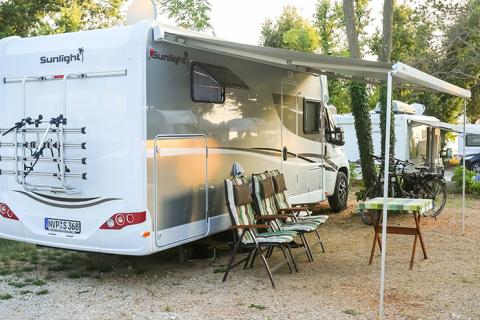
When you’re standing in the dealership in the spring making the deal on your new camper or RV, the thought of winterizing the rig is far away. In the excitement to hit the road and enjoy the great American outdoor pastime of camping, most of us hear, “Winterizing it in the fall requires, blah, blah, blah …”
Now the weather forecasters are full of foreboding predicting the season’s first freezing temperatures. You look over your mug of morning coffee and see the camper trailer parked in the yard and think, “Yikes! I need to winterize that … today!”

There’s enough difference between the various camper and RV makes and models it would be impossible to talk about each and every one. We recommend that you consult your owner’s manual or brand website for specific guidelines on winterizing your rig. In this guide, we’re offering up a few points that are universally important, and should never be forgotten when working on any camping trailer or RV. Here are some of the most important tips to remember when you're getting your camper ready for winter!
1. Use the Right Antifreeze for Campers & RVs
To prevent freezing and broken water lines, you’ll be filling the system with antifreeze, BUT ALL ANTIFREEZE IS NOT THE SAME. You need to purchase non-toxic RV antifreeze specifically made for boats and recreational vehicles. It will prevent freezing down to at least -50° F and some protection against corrosion of any metal fittings. Depending on the systems you have to fill, 2-4 gallons will be required, but consult your manual to be sure. Again, this is not the same antifreeze/coolant that goes in your automobile engine.
2. Remember to Drain All Camper & RV Tanks
There will generally be four separate tanks to deal with. They are the fresh water tank, grey water tank, black water tank, and the water heater tank. All need to be drained, and the black/grey water tanks should be thoroughly rinsed if possible. These holding tanks must be drained into a septic holding system at a park, dealer, etc. Fresh water and water heater tanks can be drained in your yard.
Tip: Check out the video below: RV Quick Tip - How To Dump the Grey and Black Tank from Fleetwood RV
3. Bypass the Camper & RV Water Heater Tank
With the water heater tank drained, you’ll want to bypass that tank when you fill the system with anti-freeze; otherwise you’ll be unnecessarily filling the tank with six or more gallons of antifreeze before it charges the rest of the system. If your rig does not have a bypass installed, you can get one at an RV/marine supplier and install it pretty easily yourself.
4. Final Antifreeze Fill-Ups
After you follow the instructions in the owner’s manual for charging the system with non-toxic RV antifreeze, there are a number of places you should follow up with a cup or two of additional antifreeze. Always pour 1-2 cups of antifreeze down each drain to fill the trap below the sink, tub, and shower. Pour 3-4 cups into toilet and flush into the black water holding tank.
5. Turn OFF the Camper or RV Water Heater for Winter Storage
If your water heater has an electric heating option, be certain the switch is turned off to protect the element if the rig is plugged in during winter storage. Tape the switch in the “off” position. It’s a good idea to turn it off at the fuse box as well. To remind yourself in the spring, just tape the fuse next to the switch for the winter.
6. Final Inspection and CLOSE the RV Faucets
As you check everything over one last time before locking the door for the winter, make sure all faucets are CLOSED, including the outdoor shower if the rig is equipped with one.
Don’t Forget...
 Just because you’ve winterized your camping trailer doesn’t mean it’s fated to stay in storage until spring. Should the urge strike, you can certainly hook it up and go wherever you’d like. Just make sure the heating system is working properly.
Just because you’ve winterized your camping trailer doesn’t mean it’s fated to stay in storage until spring. Should the urge strike, you can certainly hook it up and go wherever you’d like. Just make sure the heating system is working properly.
You can bring along water outside of the internal systems and use the restrooms/bath houses where you are camping – but do not run any water down the drains either. OR you can wait until you’re clear of freezing temps and recharge the systems. Just be sure you re-winterize before you hit the cold weather zones again.
Always err on the side of caution because repairing camper or RV frozen/broken lines, pipes, and systems is a royal pain – not to mention, expensive.
Tip: Here is a step by step RV winterizing checklist from Kampgrounds of America (KOA)
- 40145 views

